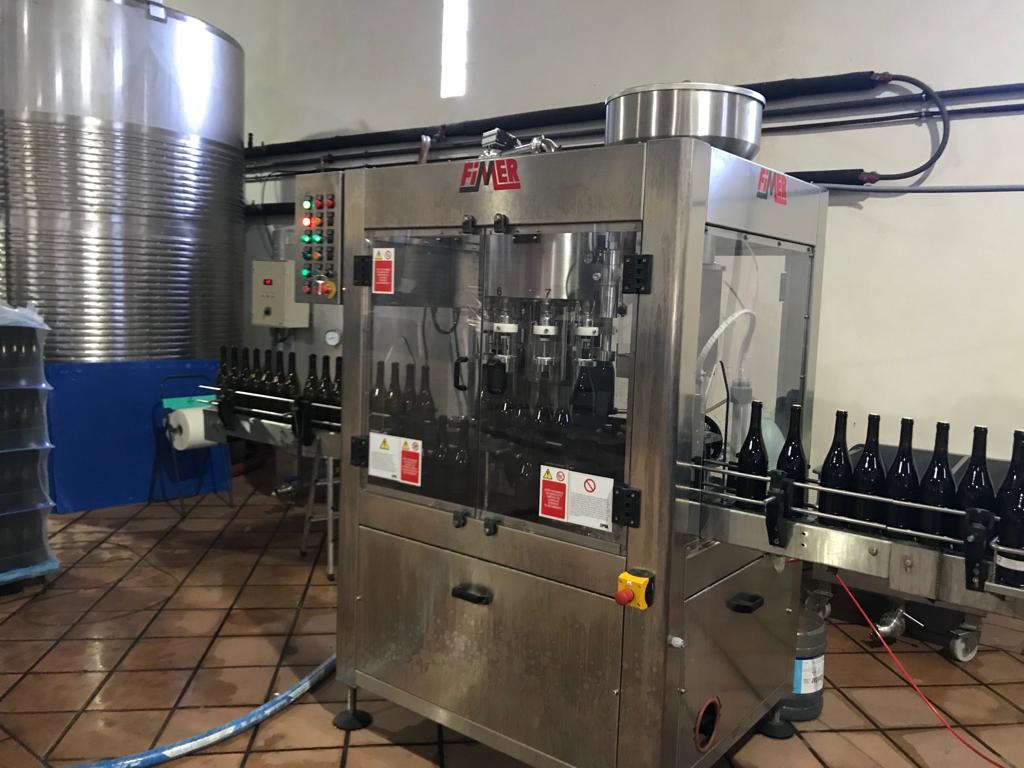"Wine gives brilliance to the countryside, exalts hearts, lights the pupils and teaches the dance to the feet." José Ortega y Gasset.
Craft and Ecological Winery

100% Manual vintage
100% Collection in boxes of 200 kg.
100% Grapes are processed at the selection table
100% Pumping and remounting take place by hand without squeezing the grapes
100% Manual bleeding by gravity
The Winery

Fachada noble

Depósitos de fermentación

Sala de barricas

Mesa de selección

Embotelladora

Tienda
Built in 2008, the winery is located in the area known as "Sierra de las Cabras" on the bank of what used to be the old riverbed of the river "Juá". Its more than 2000 meters of building are born from the bowels of the mountain itself, where after a process of clearing, the foundations of the building were settled there, thus preserving the temperatures of the land itself, both in the warm and cold seasons.
Equipped with the most modern technology, the winery has a production capacity of 200,000 kgs. of grapes, all at selection table. Winery by gravity eliminating processes such as reception in hoppers, transport in augers, pumps and long pipes, which inevitably damage the grapes.
In this cellar, something as basic as gravity is used to eliminate the continuous frictions, breakage of grains and skins and unnecessary oxidations. Through its application we have made an important qualitative leap allowing us to produce more natural wines and having obtained the Certificate of craft and ecological winery from the Government of the Murcia region.
The river Juá
by Emiliano Hernández



The river Juá is an old current of water that ran from north to south an important part of the municipal term of Jumilla. This water stream was conformed, and is still formed, by the channels of the "Alqueria", the "Cingla"and the "Jimena". The main sources that provided water were the "Cerco" and "Pradico Somero" (Praico Somero in medieval texts), both feed on the same aquifer. Along its route the fountains of "Tragapán", "La Pila" and the thermal waters of the "Cuesta de la Parra" (today Baños de Campa) are added.
On its way, when the channel reaches the height of the "Albar" place, the waters of the endorheic lagoon of the "Prado" were joined, circulating freely throughout the entire "Cañada del Judío", until they ran aground again and created a new channel in the municipal area of Cieza, in the area that keeps the name of "Rambla del Judío", to end definitively in the Segura River.
The name Juá comes from the classic Arabic language "al wadi", which means the valley, the channel. In Spanish it has remained as "Guad", semantic root used to designate many of the rivers of the Iberian Peninsula: Guadalquivir, Guadiana, Guadalorce, Guadalimar, etc. So the river Juá has lost its name and has only remained the root of Juá, Guad, "river". In the school Atlas of the publishing house Salinas, published in 1956, the river Juá is indicated with its route. Although we have to emphasize the reiteration of the name, "the river river".
The river Juá has been an artery of wealth for Jumilla. Along its route all the towns and cultures that have occupied the region have settled, from the Lower Paleolithic whose remains have been found in the Fuente del Cerco, up to several Roman villas that have settled along its bed, such as the "Pradico Somero", "Charco del Zorro", "La Pila", etc.
Over time, its waters were channeled in the XV century, and its use was regulated to irrigate the fertile orchards of Jumilla, as well as to supply the population, situation and ordinances that were maintained until the second half of the 20th century.
Tastings and guided tours
With appointment
Escríbenos a eventos@bodegasriberadeljua.com y haz la reserva de tu visita y cata
Tel: 868 187 901